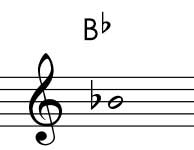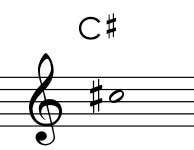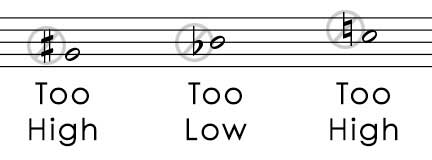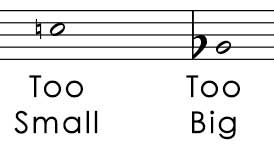Home - Music Notation - Noteheads
How to Draw Accidentals
An accidental is a musical symbol that alters the pitch of a note. There are five different accidentals:
The flat:

The sharp:

The natural:

The double flat:

The double sharp:

All accidentals are written to the left side of the notehead to which they apply, so that when we are reading music from left to right across the page, we see the accidental first, and then the note.
Drawing a flat sign
The flat sign lowers a pitch by one half step. It consists of a small loop and a stem. The loop of the flat sign is placed directly on the line or space of the notehead to which it belongs. When the flat effects a pitch that is on a space, the loop of the flat sign should be in the middle of that space. When it effects a pitch on a line, the line should run through the middle of the loop of the flat sign. The stem of the flat sign is the length of approximately two and a half staff spaces.
How to draw flat signs with correct placement of the accidentals:

Drawing a sharp sign
The sharp sign raises a pitch by one half step. It is similar to the pound sign (also called the number sign) that is produced by typing shift-3 on a computer keyboard. The horizontal lines of the sharp sign slant upwards and to the right. The space in the middle of the sharp sign is placed on the exact same staff line or space as the notehead that it effects. The height of the sharp sign is approximately three staff spaces.
How to sharp flat signs with correct placement of the accidentals:

Drawing a natural sign
The natural sign is used to cancel any previous accidentals. It looks similar to the sharp sign, but some of its lines are not as long. Just like the sharp sign, the space in the middle of the natural sign is placed on the exact same line or space as the notehead it effects. The height of the natural sign is approximately three staff spaces.
How to draw natural signs with correct placement of the accidentals:

Drawing a double flat sign
The double flat lowers a pitch by two half steps. It consists of two flat signs next to each other. The two flat signs in the double flat touch each other, as shown below. The loops of the double flat are placed on the same line or space of the notehead that it alters.
How to draw double flat signs with correct placement of the accidentals:

Drawing a double sharp sign
The double sharp looks like a fancy letter X. Its height is one staff space, and it should be centered on the same line or space as the notehead that it alters.
How to draw double sharp signs with correct placement of the accidentals:

For further explanations about accidentals and what they do, as well as an interactive keyboard that demonstrates and plays pitches with accidentals, visit this page at Sormelharf.com.
In printed music, the accidental is always on the lefthand side of the notehead that it alters, as shown in all of the examples above. However, when we write or say the name of a pitch with an accidental, we say the name of the pitch first, and then the name of the accidental. For example, the note below is called “B flat.” We do not call it “flat B.”

The example below is called “C sharp,” not “sharp C.”

Common errors in writing notes with accidentals
Avoid these common errors when writing notes with accidentals.
Floating accidentals. In the example below, none of the accidentals are on the appropriate line or space. They do not indicate whether or not the pitch should be altered.

Accidentals on the wrong side. Remember that the accidental goes on the left hand side of the notehead. The examples below are centered perfectly on the correct line or space, but they are on the wrong side of the notehead, and therefore have no meaning.

Accidentals that are the wrong size. The correct size of each accidental is demonstrated in the correct examples above. Avoid making them too big or too small.

How to Write Music
Besides blank staff paper, this site includes instructions on how to draw music notes and symbols. You can learn how to draw notes, ledger lines, clefs, rests, note values, accidentals, time signatures, and other musical symbols.
Getting started with the basics:
Noteheads
Ledger lines
Treble clef
Bass clef
Accidentals




If you like this site, please share it with others!


Like Kyle Coughlin Music on Facebook
Follow Kyle Coughlin Music on Twitter